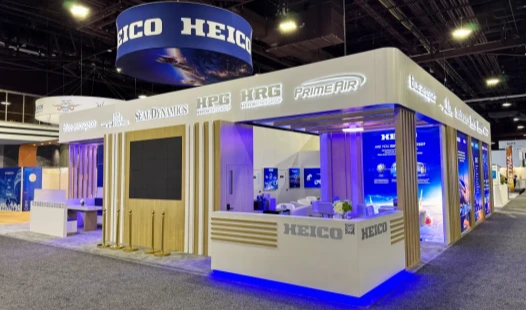Why Exhibitions Belong in Your Marketing Plan?
Exhibitions are a powerful tool in any comprehensive marketing strategy, offering unparalleled opportunities for face-to-face interactions with potential clients and industry peers. These events provide a unique platform to showcase products, build brand awareness, and generate high-quality leads. By participating in exhibitions, businesses can gain valuable market insights, stay abreast of industry trends, and foster relationships that extend far beyond the event itself. The tangible nature of exhibitions allows companies to make lasting impressions through innovative booth designs and immersive brand experiences, ultimately driving business growth and establishing a strong market presence.
The Strategic Advantage of Exhibition Participation
Participating in exhibitions offers numerous strategic advantages that can significantly boost your marketing efforts. These events serve as a melting pot of industry professionals, potential clients, and competitors, creating an environment ripe for networking and business development. By showcasing your products or services at exhibitions, you're not just selling; you're building brand credibility and establishing your company as a key player in your industry.
One of the most compelling reasons to include exhibitions in your marketing plan is the opportunity for direct customer engagement. Unlike digital marketing channels, exhibitions allow for real-time, face-to-face interactions with your target audience. This personal touch can be invaluable in building trust and fostering long-term relationships with potential clients. Moreover, the immediacy of these interactions enables you to gather instant feedback on your offerings, helping you refine your products or services to better meet market demands.
Maximizing ROI Through Strategic Exhibition Planning
To truly harness the power of exhibitions, strategic planning is essential. Start by setting clear objectives for your participation. Are you looking to launch a new product, generate leads, or simply increase brand awareness? Your goals will guide your exhibition strategy, from booth design to staff training.
Invest time in researching the right exhibitions for your business. Consider factors such as the event's reputation, attendee demographics, and the presence of your target audience. Once you've selected the right events, focus on creating a memorable booth experience. An innovative and visually appealing booth design can significantly increase foot traffic and engagement at your stand.
Don't underestimate the importance of pre-show marketing. Leverage social media, email campaigns, and industry networks to create buzz around your exhibition presence. This proactive approach can help you schedule meetings with key prospects in advance, ensuring a productive event.
Leveraging Exhibitions for Market Research and Competitive Analysis
Exhibitions are not just platforms for showcasing your offerings; they're also invaluable sources of market intelligence. These events bring together a diverse array of industry players, providing a unique opportunity to conduct real-time market research and competitive analysis.
By attending exhibitions, you can gain firsthand insights into emerging industry trends, new technologies, and shifting customer preferences. This information is crucial for staying ahead of the curve and adapting your products or services to meet evolving market demands. Observe your competitors' booths, marketing materials, and engagement strategies to benchmark your own performance and identify areas for improvement.
Gathering Actionable Insights Through Exhibition Interactions
Exhibitions offer a goldmine of qualitative data that can inform your marketing strategy. Engage in meaningful conversations with attendees to understand their pain points, preferences, and perceptions of your brand. These interactions can reveal valuable insights that might not be captured through traditional market research methods.
Consider implementing interactive elements in your booth, such as surveys or product demonstrations, to gather structured feedback from visitors. This data can be analyzed post-event to identify trends and inform future product development or marketing initiatives.
Don't forget to pay attention to the questions and comments you receive from booth visitors. These can highlight areas of your product or service that may need clarification in your marketing materials or reveal untapped market opportunities.
Post-Exhibition Strategies for Long-Term Success
The work doesn't end when the exhibition closes its doors. In fact, your post-exhibition strategy can be just as crucial as your performance during the event itself. A well-executed follow-up plan can transform the connections made at the exhibition into tangible business opportunities.
Begin by organizing and categorizing the leads collected during the event. Prioritize these leads based on their potential value and readiness to engage. Develop a tailored follow-up strategy for each category, ensuring that your communication is timely, relevant, and adds value to the initial interaction at the exhibition.
Nurturing Leads and Measuring Exhibition ROI
Implement a robust lead nurturing program to keep your brand top-of-mind with potential clients. This could include personalized email campaigns, targeted content marketing, or invitations to exclusive webinars or events. The key is to maintain engagement and guide prospects through your sales funnel.
Measuring the return on investment (ROI) of your exhibition participation is crucial for refining your future strategies. Track key performance indicators such as the number of leads generated, meetings conducted, and deals closed as a result of the exhibition. Compare these metrics against your initial objectives to evaluate the success of your participation.
Consider conducting a post-event survey with your team to gather insights on what worked well and areas for improvement. This internal feedback can be invaluable for optimizing your approach to future exhibitions.
Conclusion
Incorporating exhibitions into your marketing plan offers a multifaceted approach to achieving your business objectives. From fostering face-to-face connections and gathering market insights to showcasing your brand and products, exhibitions provide unique opportunities that complement and enhance your overall marketing strategy. By strategically planning your participation, leveraging the event for market research, and implementing effective post-exhibition follow-up, you can maximize the impact of these events on your business growth. As the marketing landscape continues to evolve, exhibitions remain a powerful tool for building relationships, driving innovation, and establishing your brand as a leader in your industry.
Ready to make your mark at your next exhibition? HR Exhibits, a leading exhibition booth design company, is here to help you create a lasting impression. With our comprehensive services and innovative designs, we can transform your exhibition presence into a powerful marketing tool. Contact us at info@hrexhibits.com to discover how we can elevate your exhibition strategy and bring your brand vision to life.
FAQs
Q: How far in advance should I start planning for an exhibition?
A: Ideally, start planning 3-5 months before the event. This allows ample time for booth design, fabrication, and logistics planning.
Q: What services does HR Exhibits offer?
A: We provide end-to-end solutions including custom booth design, fabrication, graphics, logistics, installation, and dismantling. We also offer rental options for furniture, AV equipment, and lighting.
Q: Can HR Exhibits handle last-minute exhibition requests?
A: Yes, our team is flexible and capable of handling urgent projects. However, for the best results, we recommend reaching out as early as possible.
References
1. Smith, J. (2022). The Impact of Trade Shows on B2B Marketing Strategies. Journal of Exhibition Management, 15(2), 45-60.
2. Johnson, A. & Brown, M. (2021). Maximizing ROI in Exhibition Participation: A Comprehensive Guide. Exhibition World Press.
3. Lee, S. (2023). Digital Integration in Modern Exhibition Design. Tech in Events Quarterly, 8(1), 12-25.
4. Garcia, R. et al. (2022). Post-Exhibition Engagement: Strategies for Long-Term Lead Nurturing. Marketing Insights Magazine, 30(4), 78-92.
5. Thompson, K. (2023). The Evolution of Exhibition Marketing in a Post-Pandemic World. International Journal of Event Management, 18(3), 301-315.

Embark on Your Journey to Exceptional Exhibitions! Contact HR Exhibits Today to Transform Your Vision into Global Success.

HR Exhibits Service, Inc.


